Paper Menu >>
Journal Menu >>
 Advances in Pure Mathematics, 2012, 2, 203-210 http://dx.doi.org/10.4236/apm.2012.23029 Published Online May 2012 (http://www.SciRP.org/journal/apm) Weinstein Gabor Transform and Applications Hatem Mejjaoli1, Ahmedou Ould Ahmed Salem2 1Department of Mathematics, College of Sciences, King Faisal University, Ahsaa, KSA 2Department of Mathematics, College of Education, King Khalid University, Mohayil, KSA Email: hmejjaoli@kfu.edu.sa, ahmdoo@kku.edu.sa Received January 12, 2012; revised February 28, 2012; accepted March 7, 2012 ABSTRACT In this paper we consider Weinstein operator. We define and study the continuous Gabor transform associated with this operator. We prove a Plancherel formula, an inversion formula and a weak uncertainty principle for it. As applications, we obtain analogous of Heisenberg’s inequality for the generalized continuous Gabor transform. At the end we give the practical real inversion formula for the generalized continuous Gabor transform. Keywords: Weinstein Gabor Transform; Practical Real Inversion Formula; Kernel Reproducing Theory 1. Introduction We consider the Weinstein operator defined on 0, d by : 2 121 :, d 2 111 1 2d idd ixx x where d is the Laplacian for the d-first variables and the Bessel operator for the last variable, given by 2 2 11 21 1 ,. 2 dxx >2d 1dd x For , the operator is the Laplace-Beltrami operator on the Riemanian space 0, d equipped with the metric 1 1 1 22 1 1 dd d d di i 22 s xx (cf. [1]). The Weinstein operator 2 L has several applications in pure and applied Mathematics especially in Fluid Me- chanics (cf. [3]). The harmonic analysis associated with the Weinstein operator is studied by Ben Nahia and Ben Salem (cf. [1,2]). In particular the authors have introduced and studied the generalized Fourier transform associated with the Weinstein operator. This transform is called the Weinstein transform. In this work we are interested to the Gabor transform associated with Weinstein operator. Time-Frequency analysis plays a central role in signal analysis. Since years ago, it has been recognized that the global Fourier transform of a long time signal has a little practical value to method is preferred to the classical Fourier method, whenever the time dependence of the analyzed signal is of the same importance as its fre- quency dependence. However, there exist strict limits to the maximal Time- Frequency resolution of this transform, similar to Heisen- berg’s uncertainty principles in the Fourier analysis. In fact, Dennis Gabor [4] was the first to introduce the Gabor transform, in which he uses translations and modu- lations of a single Gaussian to represent one dimensional signal. Other names for this transform used in literature, are: short time Fourier transform, Weyl-Heisenberg trans- form, windowed Fourier transform. In this paper, we are interested a generalized Gabor transform associated for the Weinstein transform. More precisely, we give here general reconstruction formulas and we give many applications. In the classical case the Gabor transform is very fundamental and has many ap- plications to Mathematical Sciences. The paper is organized as follows. In Section 2, we re- call the main results about the harmonic analysis related to the Weinstein operator. In Section 3, we introduce the analogue of the continuous Gabor transform associated with the Weinstein operator and we give some harmonic properties for it (Plancheral formula, inverse formula, weak uncertainty for it). The Section 4 is devoted to prove the analogous of Heisenberg’s inequality for the general- ized continuous Gabor transform. In Section 5 using the kernel reproducing theory given by Saitoh [5] we study the problem of approximative concentration. In the last section we give a practical real inversion formulas and extremal function for the Weinstein-Gabor transform. 2. Preliminaries In order to confirm the basic and standard notations we C opyright © 2012 SciRes. APM 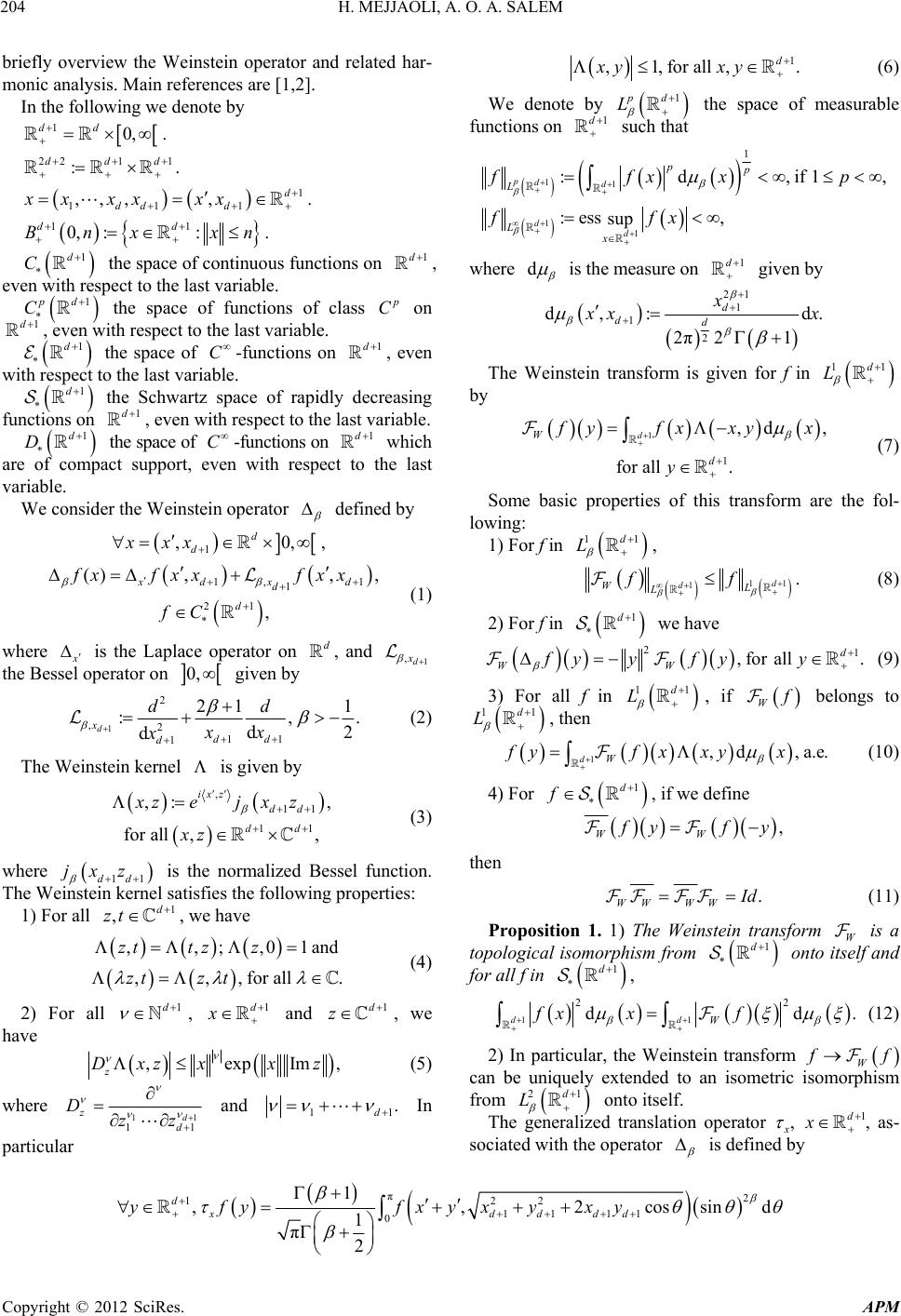 H. MEJJAOLI, A. O. A. SALEM 204 briefly overview the Weinstein operator and related har- monic analysis. Main references are [1,2]. 1 ,1,forall, . d xyxy In the following we denote by 0, dd 1 1ddd 1 1 ,d d xx 1 . 22 :. 11 ,,, dd xx xx . 11 : dd xn C1d 0, :Bnx 1d . the space of continuous functions on 1pd C , even with respect to the last variable. the space of functions of class p C on , even with respect to the last variable. 1d 1d the space of C -functions on 1d 1d 1d 1d D C1d , even with respect to the last variable. the Schwartz space of rapidly decreasing functions on , even with respect to the last variable. the space of -functions on which are of compact support, even with respect to the last variable. We consider the Weinstein operator defined by ,0, d 1 1, , x d fxx 1d xxx , 1, 21 () , , xd d d fx fxx fC (1) where x 1 ,d x is the Laplace operator on , and d the Bessel operator on 0, given by 1 2 ,2 1 21 d d x d dd xx x 11 1 :,. d2 dd (2) The Weinstein kernel is given by 11 11 , , dd dd j xz 11dd jxz 1 ,d zt ;,01and ,forall. z 1x1d z , ,: for all, ixz xz e xz (3) where is the normalized Bessel function. The Weinstein kernel satisfies the following properties: 1) For all , we have ,, ,, zt tz ztz t (4) 2) For all , and d 1d , we have xpIm,x z,e z Dxz x (5) where 1 11 d 1d zz z D and 11 . d In particular (6) We denote by 1pd L 1d the space of measurable functions on such that 11 1 1 1 :d,if1, :ess , sup pdd dd pp L Lx ffxxp ffx d where is the measure on given by 1d 21 1 1 2 d,: d. 2π21 d dd x x xx The Weinstein transform is given for f in 11d L by 1 1 ,d , for all. d W d f yfxxyx y (7) Some basic properties of this transform are the fol- lowing: 11d L , 1) For f in 11 1. d d WL L ff (8) 1d we have 2) For f in 21 ,for all. d WW fy yfyy (9) 11d L W , if 3) For all f in f belongs to 11d L , then 1,d ,a.e dW fyf xxyx . (10) 1d f , if we define 4) For , WW fyf y then . WW WW I d 1d (11) Proposition 1. 1) The Weinstein transform W is a topological isomorphism from onto itself and for all f in 1d , 11 22 dd dd W fx xf . (12) W 2) In particular, the Weinstein transform f f can be uniquely extended to an isometric isomorphism from 21d L The generalized translation operator onto itself. x , 1d x , as- sociated with the operator is defined by π2 122 11 11 0 1 ,,2cossind 1 π 2 xd ddd y fxyxyxy d yf Copyright © 2012 SciRes. APM 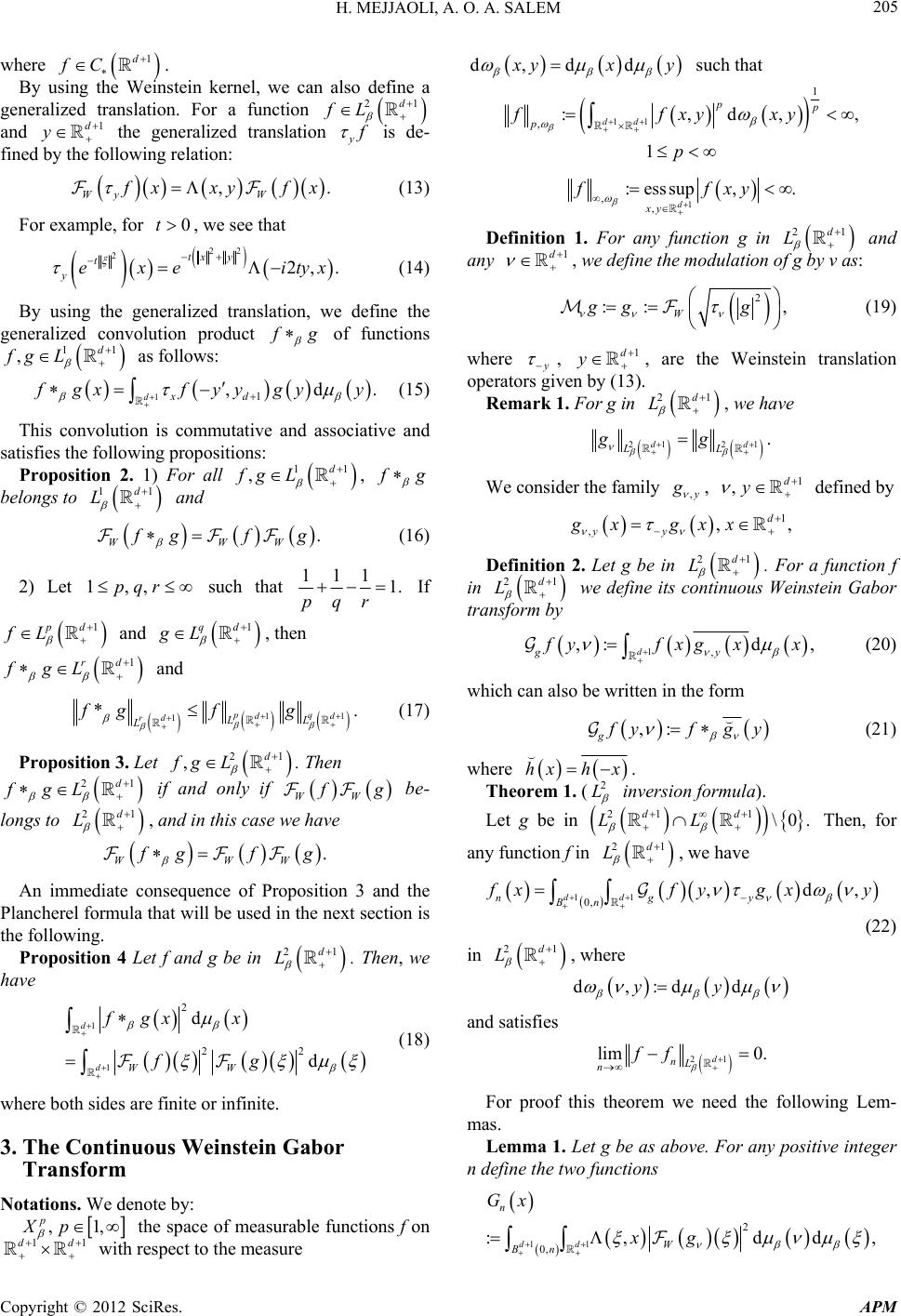 H. MEJJAOLI, A. O. A. SALEM 205 where . 1d fC d,d d x yxy such that By using the Weinstein kernel, we can also define a generalized translation. For a function 21d fL 1d y y and the generalized translation f is de- fined by the following relation: Wy fx x , W y fx 0t . (13) For example, for , we see that 22 2tx y t yexe 2, .ityx (14) By using the generalized translation, we define the generalized convolution product f g 11d L d. of functions as follows: ,fg 11 , dxd f gxfyy gy y 11d (15) This convolution is commutative and associative and satisfies the following propositions: Proposition 2. 1) For all , ,fg L f g belongs to and 11d L . WWW f gfg ,pqr (16) 2) Let 1, such that 111 1. pqr 1qd gL If and , then and 1p fL fgL d 1rd 11 *. pq dd LL g 21d L 1rd L fgf (17) Proposition 3. Let . Then ,fg 21d L fg if and only if WW f g 21d L . W be- longs to , and in this case we have WW f gfg 21d L An immediate consequence of Proposition 3 and the Plancherel formula that will be used in the next section is the following. Proposition 4 Let f and g be in . Then, we have 2 d 1 1 2 2 d d dWW fgx x fg (18) where both sides are finite or infinite. 3. The Continuous Weinstein Gabor Transform Notations. We denote by: ,1, p Xp 11dd the space of measurable functions f on with respect to the measure 11 1 ,:,d,, 1 dd pp p ff xyxy p 1 , , : esssup,. d xy ffxy 21d L 1d Definition 1. For any function g in and any , we define the modulation of g by v as: 2 :: , W gg g (19) 1d y where y , , are the Weinstein translation operators given by (13). 21d L , we have Remark 1. For g in 21 21 . d dL L gg , g We consider the family y 1 ,d y , defined by 1 ,,, d yy gx gxx 21d L Definition 2. Let g be in . For a function f in 21d L we define its continuous Weinstein Gabor transform by 1, ,:d , d gy f yfxgxx (20) which can also be written in the form ,: g f yfgy (21) hxhx where 2 L. Theorem 1. ( inversion formula). 21 1 \0. dd LL Then, for Let g be in 21d L , we have any function f in 11 0, ,d, dd ngy Bn xfygxy f (22) 21d L , where in d,:d dyy and satisfies 21 lim 0. d nL nff For proof this theorem we need the following Lem- mas. Lemma 1. Let g be as above. For any positive integer n define the two functions 11 2 0, :,dd, dd n W Bn Gx xg Copyright © 2012 SciRes. APM 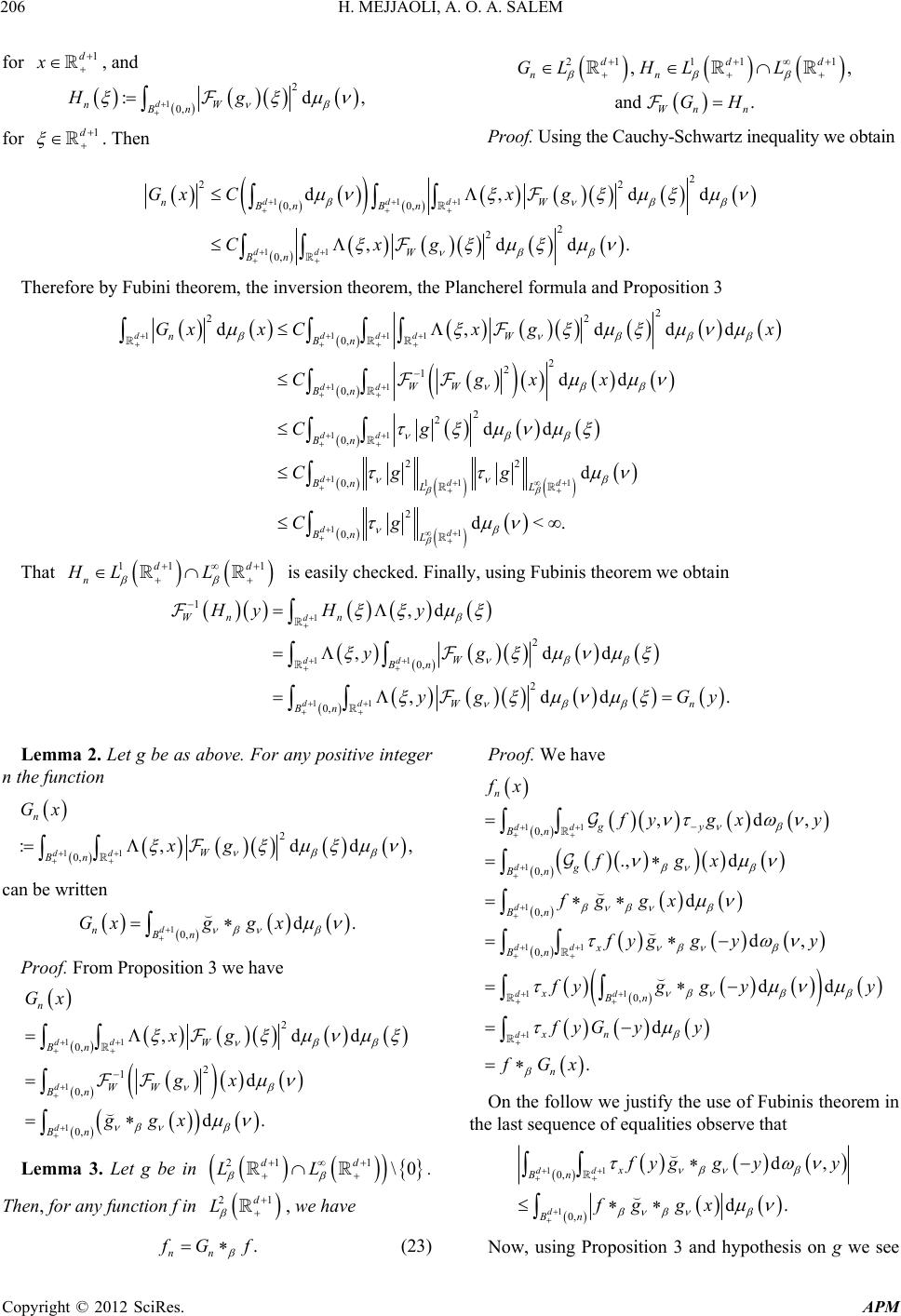 H. MEJJAOLI, A. O. A. SALEM 206 for 1d x , and 2 :d, 21 111 ,, and . ddd nn Wnn GL HLL GH 10, d nW Bn Hg 1d for . Then Proof. Using the Cauchy-Schwartz inequality we obtain 111 11 2 2 2 0, 0, 2 2 0, d,dd ,dd. ddd dd n W Bn Bn W Bn Gx Cxg Cxg 3 Therefore by Fubini theorem, the inversion theorem, the Plancherel formula and Proposition 1111 11 111 1 11 2 2 2 0, 0, 2 2 0, 22 0, 2 0, d,ddd dd d d<. dddd dd ddd dd nW Bn Bn Bn Bn LL Bn L Gxx Cxgx Cg Cgg Cg That 11 2 2 1dd dd WW Cg xx 11 1dd n HL L is easily checked. Finally, using Fubinis theorem we obtain 1 11 1 2 0, ,d ,dd. d dd Wn n Wn Bn Hy Hy yg Gy 11 2 0, ,d d dd W Bn yg Lemma 2. Let g be as above. For any positive integer n the function 11 2 0, :,dd, dd W Bn xg nxG can be written d. 10, d nBn Gxg gx roposition 3 we have Proof. From P 1 2 2 1 0, d d d n WW Bn xg gx 10, d. d Bn gg x 11 0, ,d dd W Bn Gx Lemma 3. Let g be in 1 \0 dd . 21 LL Then, for any function f in 21d L , . nn we have f Gf (23) Proof. We have 11 1 11 1 0, 0, ,d, d d d, dd d . dd d dd d n gy Bn xBn xn n fx fy gxy x fg gx fygg yy 1 0, 0, ., d Bn g Bn fg 11 0, dd x Bn f yggy y fyG yy fGx On the follow we justify the use of Fubinis theorem in the last sequence of equalities observe that 11 1 0, 0, d, d. dd d x Bn Bn f ygg yy fg gx Now, using Proposition 3 and hypothesis on g we see Copyright © 2012 SciRes. APM 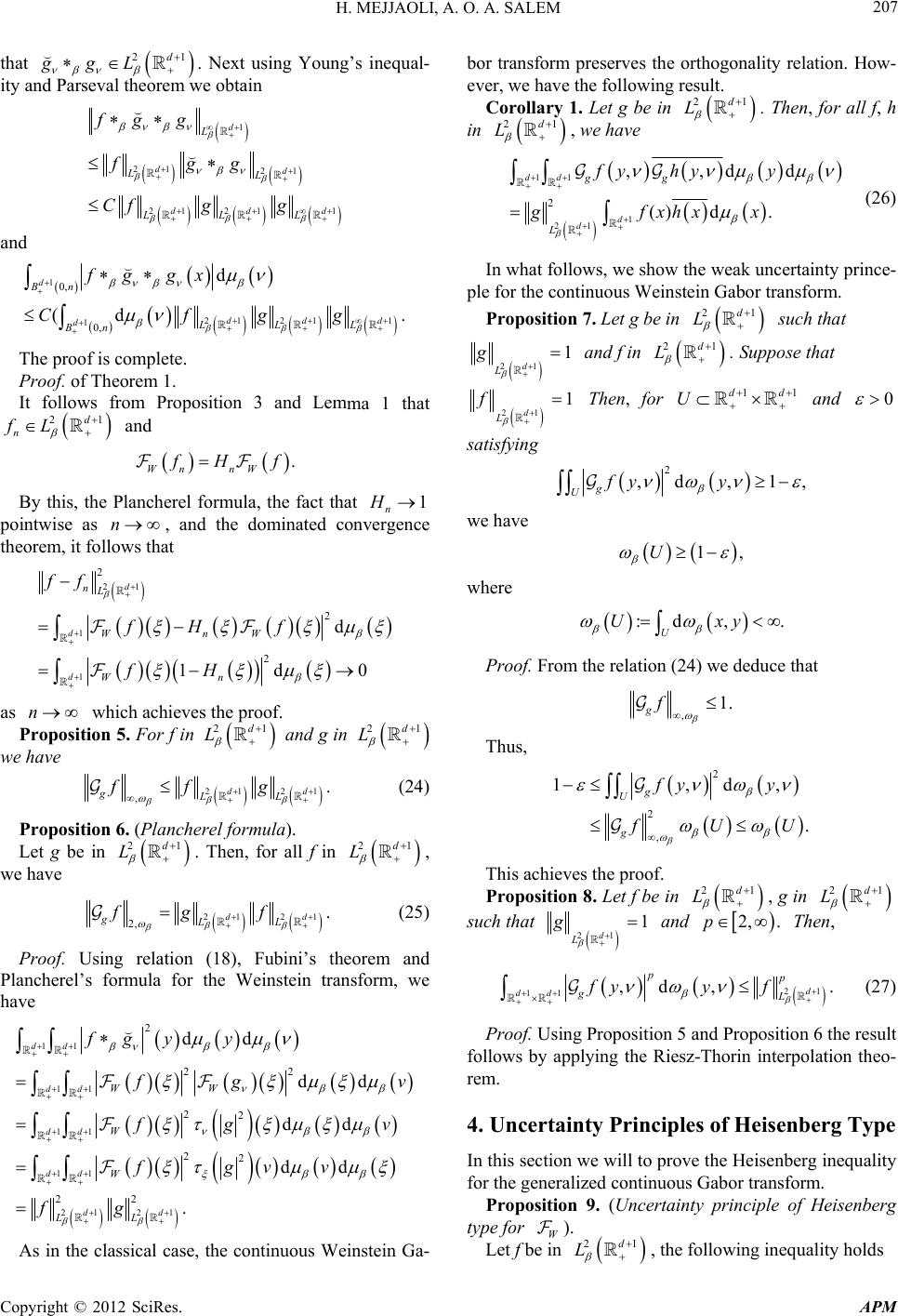 H. MEJJAOLI, A. O. A. SALEM 207 that gg ity and Parsev 21d L . Next using Young’s inequal- al theorem we obtain 21 1 1 d ddd L L g g and 1 21 212 d d L L LL fg g fg Cfg 21 1 . d L gg The proof is complete. ma 1 that n fL and . nW 1 21 1 0, 0, d (d d dd d Bn LL Bn fg gx Cf Proof. of Theorem 1. It follows from Proposition 3 and Lem 21d Wn f Hf By this, the Plancherel formula, thehat 1 n H em, it follows that fact t pointwise as n, and the dominated convergence theor 2 2 d 1d0 d d nL WnW Wn fH f fH 21 1 1 2 d ff which achieves the proof. ositi r f in as n Propon 5. Fo 21d and g in L 21d L we have 2121 . dd LL g () erel formula). The in , gff 24 Proposition 6. (Planch Let g be in 21d L . n, for all f 21d L , we have 21 21 . dd LL g f (25) Proof. Using relation (18), Fubini’s theorem and Pl , we 2, gf ancherel’s formula for the Weinstein transform have 21 21 . dd LL 11 2d dd fgy 11 11 11 2 2 22 22 2 d dd dd dd dd dd dd WW W W y 2 f gv f gv fgvv e classical case, the continuous Weinstein Ga- bor transform preserves the orthogonality re ever, we have the following result. Then, for all f, h in fg As in th lation. How- Corollary 1. Let g be in 21d L . 21d L , we have 11 1 2 ,,dd () d. dd d gg fy hyy gfxhxx 21d L e continuous Weinstein Gabor transform. Proposition 7. Let g be in 21d L such that In what follows, we show the weak uncertainty prince- ple for th (26) 21d L . Suppose that 21 1 d L g and f in 21 1 d L f Then, for 11dd U and 0 satisfying 2 ,d,1, g Ufy y we have 1,U where :U d ,. Uxy Proof. From the relation (24) we deduce that ,1. gf Thus, , 2. 2 1,d, g Ufy y g f UU This achieves Proposition 21d L , g i the proof. 8. Let f be inn 1d 2 L such that 21 1 d L g and 2, .p Then, 21 11 ,d ,. d dd pp gL fyy f (27) Proof. Using Proposition 5 and Proosition 6 the result follows by applying the Riesz-Thorinterpolation theo- 4. Uncertainty Principles of Heisenberg Type Inequality for the generalized continuous Gaboansform. Proposition 9. (Uncertainty principle of Heisenberg type for ). n p n i rem. this section we will to prove the Heisenberg in r tr W Let f be i 21d L , the following inequality holds Copyright © 2012 SciRes. APM 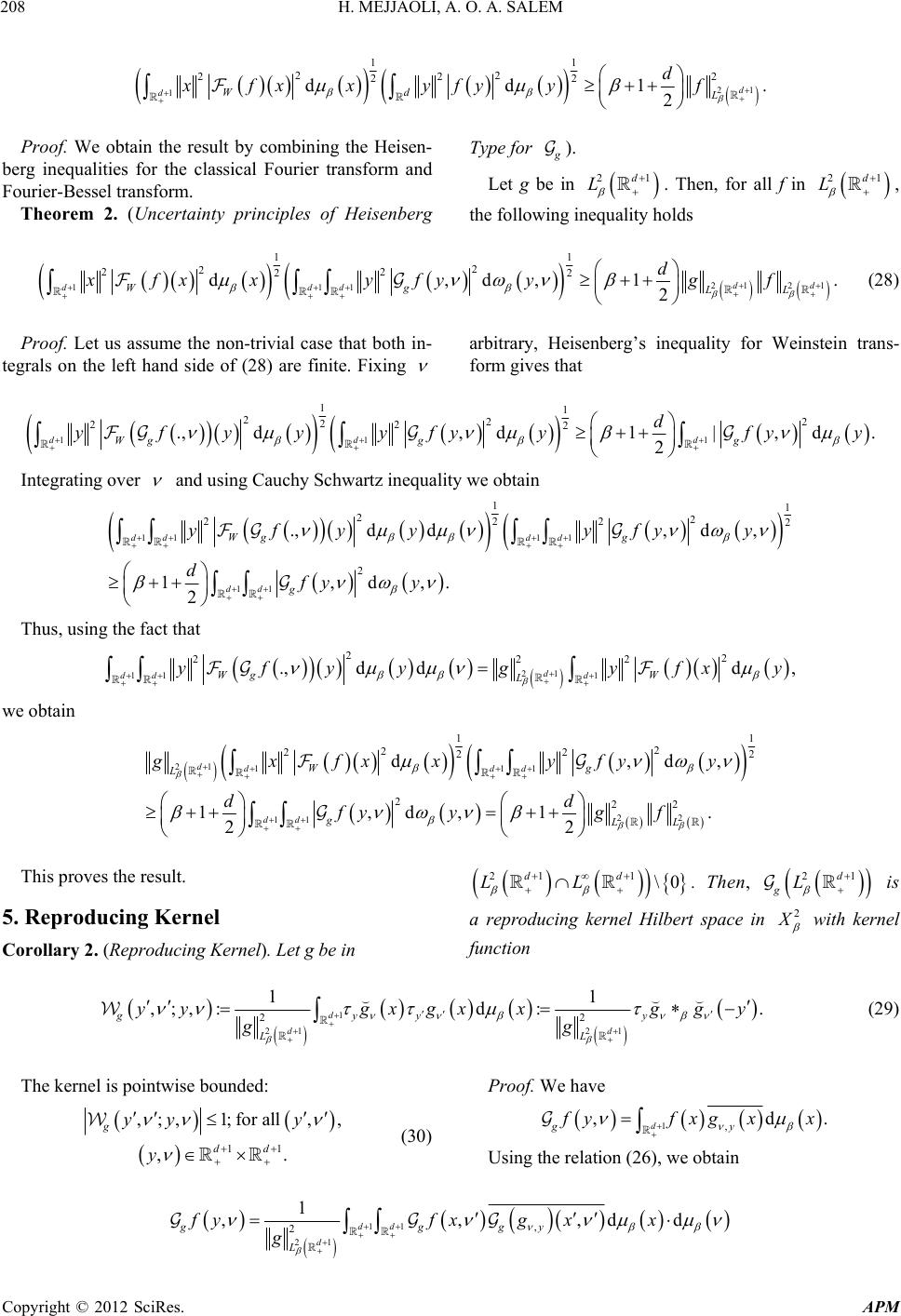 H. MEJJAOLI, A. O. A. SALEM Copyright © 2012 SciRes. APM 208 21 1 22 2 d1. 2d L d y yf 1 1 2 22 2 d dd W xf x yf lt by combining the Heisen- besical Fourier tsform and Fo m 2. (Uncertrinciples berg x Proof. We obtain the resu rg inequalities for the cl Type for g ). as ran urier-Bessel transform. Let g be in 21d L . Then, for all f in 21d L , the following inequality holds Theore ainty pof Heisen 21 21 111 1 2 2 1 2 2 g fy 2 2 d,1 2 dd d xf x xy Proof. Let us assume the non-trivial case that both in- grals on the left hand side of (28) are finite. Fixing d, . dd LL d yg f (28) W arbitrary, Heisenberg’s inequality for einstein trans- form gives that W te 11 1 22 22 ., d dWg yf yyyf 1 22 1 2 , 1. 2 dgd y y d|, d dg y fy Integrating over and using Cauchy Schwartz inequality we obtain 11 1, d, 2ddgfy y 11 11 11 22 2 22 2 2 .,dd, d, . dd dd Wg g yfyyyfy y d Thus, using the fact that 2 ,y we obtn 21 11 1 22 22 .,d dd d dd d Wg W L yfyygyfx ai 1 2 2 22 2 2 222 d,d, 1,d,1. 22 dddd dd Wg L gLL gxfxxyfyy dd fyyg f 2. (Reproducing Kernel). Let g be in 21 111 22 11 1 \0LL This proves the result. 21 1dd . Then, 21d gL is t space in a reproducing kernel Hilber2 5. Reproducing Kernel X with kernel function Corolla ry . y ggy (29) Th 1 21 21 22 11 ,;,:d: d d d gyy LL yygxgx x gg e kernel is pointwise bounded: 11 1;forall,, . dd y , y ,;, gyy (30) Proof. We have 1 ,d. d g f ,y yfxx gx Using the relation (26), we obtain 11 21 , 2 ,, ,dd dd d gggy L fyfxgxx g 1 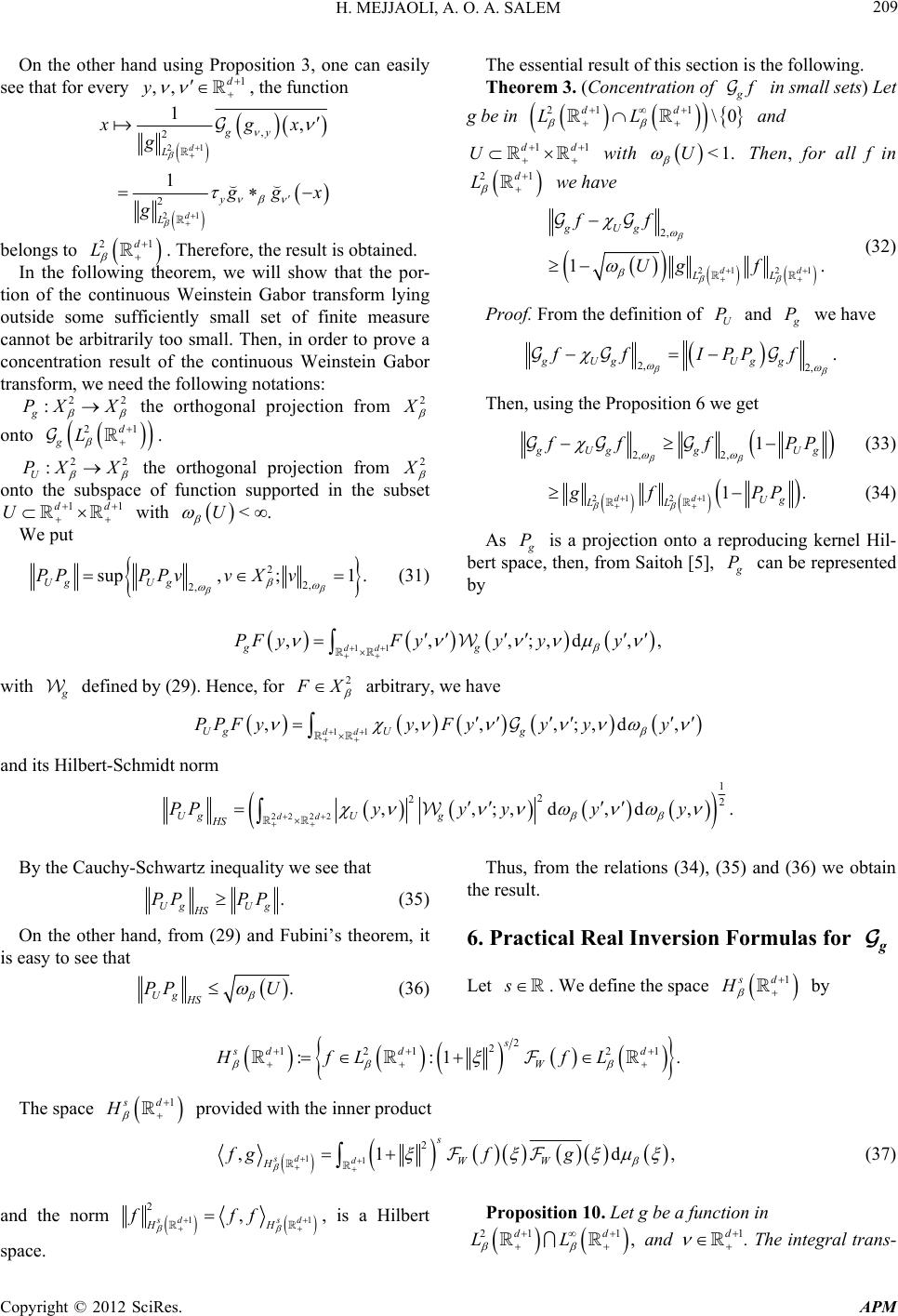 H. MEJJAOLI, A. O. A. SALEM 209 On the other hand using Proposition 3, one can easily 1 ,, d The essential result of this section is Theorem 3. (Conce ntration of g see that for every y , the function 21 , 2 2 1, 1 d gy y L xgx 21d L g g gx g o 21d L . Therefore, the result is obtained. llowing theorem, we will show that the por- tion of the continuous Weinstein Gabor transform lying utside some sufficiently small set of finite measure a f the cont the following 22 :PX X be ngs t In the fo lo o c nnot be arbitrarily too small. Then, in order to prove a concentration result oinuous Weinstein Gabor transform, we need notations: g the orthogonal projecton from 2 i X 21d gL . 22 : U PXX onto the orthogonal prn from 2 ojectio X o the subspace of function supported in the subset <.U ont U11dd with We put 2 2, 2, sup,;1. Ug Ug PPPPvv Xv (31) the following. f g be in in small sets) Let 21 1 \0 dd LL and U <1.U Then, for all f in 11dd with 21d L we have 21 21 1. dd LL Ug f (32) Proof. From the definition of U P and 2, gUg ff g P we have 2, 2, gUgUg , sing the Propo ge .ff IPPf g usition 6 we Thent 2, 1 g Ug 2, gU g f ffPP (33) 21 1. Ug LL f PP (34) As 21dd g g P is a projection onto a reproducing k bert space, then, from Saitoh [5], ernel Hil- g P can be re by presented ,;,d,, g y yy 11 ,, dd g PF yFy with g defined by (29). Hence, for 2 F X arbitr, warye have ,;,d,yyy 11 ,,, dd UgU g PPF yyF y and its Hilbert-Schmidt norm 22 22 1 2 22 ,,;,d,d,. dd U g yy yyy lity we see tha Ug HS PP By the Cauchy-Schwartz inequat . Ug Ug HS PPPP (35) On the other hand, from (29) and Fubini’s theorem, it is easy to see that . Ug PP U (36) Let s HS 5) sult. 6. Practical Real Inversion Formulas for g Thus, from the relations (34), (3 and (36) we obtain the re . We define the space 1sd H by 2 2 121 21 ::1 . s d d W fL fL The space H provided with the inner product sd H 1sd dfg 2, s WW 11 ,1 sd d H fg (37) and the norm 11sd sd HH 2,fff , is a Hilbert space. Proposition 10. Let g be a function in 21 1 , dd LL and 1d . The integral trans- Copyright © 2012 SciRes. APM  H. MEJJAOLI, A. O. A. SALEM 210 form ., g , is a bounded linear operator from 1sd H ,o s in , int 21d L , and we have 11 21 ., . dsd d gLH fgf L Proof. We proceed as [6] we obtain the result. Definition 3. Let g be a function in LL >0, 1d and sefine the f 1sd H product: 21 1 . Let r dd . We dilbert space ,1rs d H as the H with the inner subspace o 21 ., , . d L rm associated to the inner product is defined by: ,1 1 ,=, .,, , rss dgg HH sd fh rfhfh fh H The no 121 ,. sd d L ,:. rs g HH frf proceed Proposi . L a function LL 2 22 f We as [6] we prove the following results. tion 11et g be in 21 1dd . For 12 s , the Hilbert rs H admits the following reproducing d space ke ,1d rnel: 122 d ,. d g Px y ,,xy 1rg s 4. Let g be LL Theorem a function in 21 1dd . Let 12 d s . 1) Fo 21 L for any 0r, the infin r any h ind and itum 21 2 inf ., sd d sd g HL fH rfh f (38) is 1 1 2 attained by a unique function ,rh f given by 1 ,,d d rh r , f xhyQxyy (39) e wher 1 , 2 22 ,, ,, d. 1 d rrs s QxyQ xy gxy rg (40) 2) Let ,0r 21d L such that and ,hh in 21 . d L hh Then 1 ,, . 2 sd rhrhH ff r 3) Let >0r. If f is in 1sd H and ., gfh Then . 1 2 ,s 0. sd rh ff r 0a H REFERENCES [1] Z. B. Nahia and N. B. Salem, “Spherical Harmonics and Applications Associated with the Weinstein Operator,” Po- tential Theory—ICPT 94, 1996, pp. 235-241. [2] Z. B. Nahia and N. B. Salem, “On a Mean Value Property Associated with the Weinstein Operator,” Potential The- ory—ICPT 94, 1996, pp. 243-253. [3] relot, “E et Pote cel Riesz,” Lecture Notes in Mathematics 681, Séminaire de Théorie de Potentiel Paris, No. 3,, pp. 18-38. [4] bor, “Theory of Communication,” Proceedings of the Institute of Electrical Engineers, Vol. 93, No. 26, 1946, pp. 429-457. [5] S. Saitoh, “Theory of Reproducing Kernels and Its Ap- cientific TeHarlow, 1988. ejjaoli and N. Sraieb, “Gabor Transform in Quantum and Applications,” Fractional Calculus and Ap- plied Analysis, Vol. 12, No. 3, 2009, pp. 320-336. M. Bquation de Weinsteinntiels de Mar- 1978 D. Ga plications,” Longman Schnical, [6] H. M Calculus Copyright © 2012 SciRes. APM |

